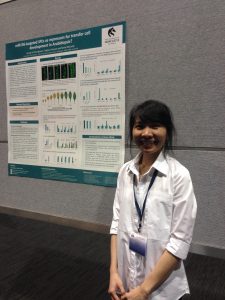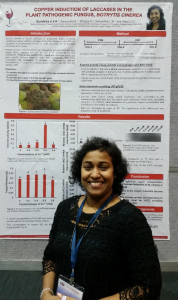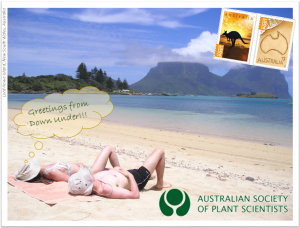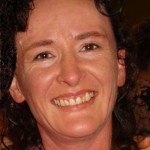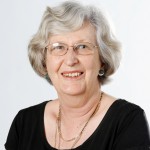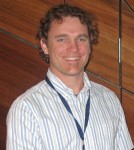- About
- Members
- Join
- Member log in
- Membership Renewal
- Member directory
- Life Members
- ASPS Life Member Professor Graham Farquhar
- ASPS Life Member Associate Professor Hendrik (Hank) Greenway
- ASPS Life Member Dr Marshall (Hal) D Hatch
- ASPS Life Member Dr Paul E Kriedmann
- ASPS Life Member Dr Mervyn Ludlow
- ASPS Life Member Emeritus Professor Rana Munns
- ASPS Life Member Conjoint Professor Christina E Offler
- ASPS Life Member Professor (Charles) Barry Osmond
- ASPS Life Member Emeritus Professor John W Patrick
- ASPS Life Member Dr Joe Wiskich
- Corresponding Members
- Elected Fellows
- Events
- Awards & Funding
- Employment
- Publications
- Research
- Teaching
- Menu
Crop Simulation Software Helps to Find Better Crops
23 January 2018
Plant researchers have developed an online application that predicts how crop growth is affected by photosynthetic changes at the molecular, cellular or leaf level of plants.
Food production depends on photosynthesis, the process by which plants capture sunlight and convert it into plant growth, biomass and grain. In the next decades, the world population is expected to reach 9.5 billion and food demand will increase significantly, so improving photosynthesis has become a global research priority.
“Enhancing photosynthesis has the potential to increase crop yields, but the link between photosynthesis and crop productivity is not straightforward because it crosses multiple scales of biological organisation. We created modelling tools that help us navigate through these complexities to identify targets that have the greatest impact on crop yield,” says Dr Alex Wu, a researcher with the ARC Centre of Excellence for Translational Photosynthesis (CoETP) at the University of Queensland.
This online “crystal ball” of crop growth, a small part of the cross-scale model, is designed to show researchers what would happen to a crop canopy with changes in photosynthesis under variable environmental and canopy conditions such as radiation, temperature, levels of CO2, canopy size and amount of nitrogen in leaves.
“Developing simulation tools like these, we are working towards connecting lab-based research and discoveries, at the leaf or molecular level, with crop productivity under variable environmental conditions,” Dr Wu said.
ARC CoETP Chief Investigator Professor Graeme Hammer says that researchers could now use the online application and see how their work is having an impact on crops in the field, which will radically accelerate the discovery process.
“They can also incorporate high temperature or high CO2 conditions to test effects of climate change,” he said.
The Diurnal Canopy Photosynthesis Simulator (DCaPS) online application, calculates diurnal (period from sunrise to sunset) canopy CO2 assimilation and daily biomass increment for a crop under well-watered conditions. DCaPS is now publicly available at www.dcaps.net.au.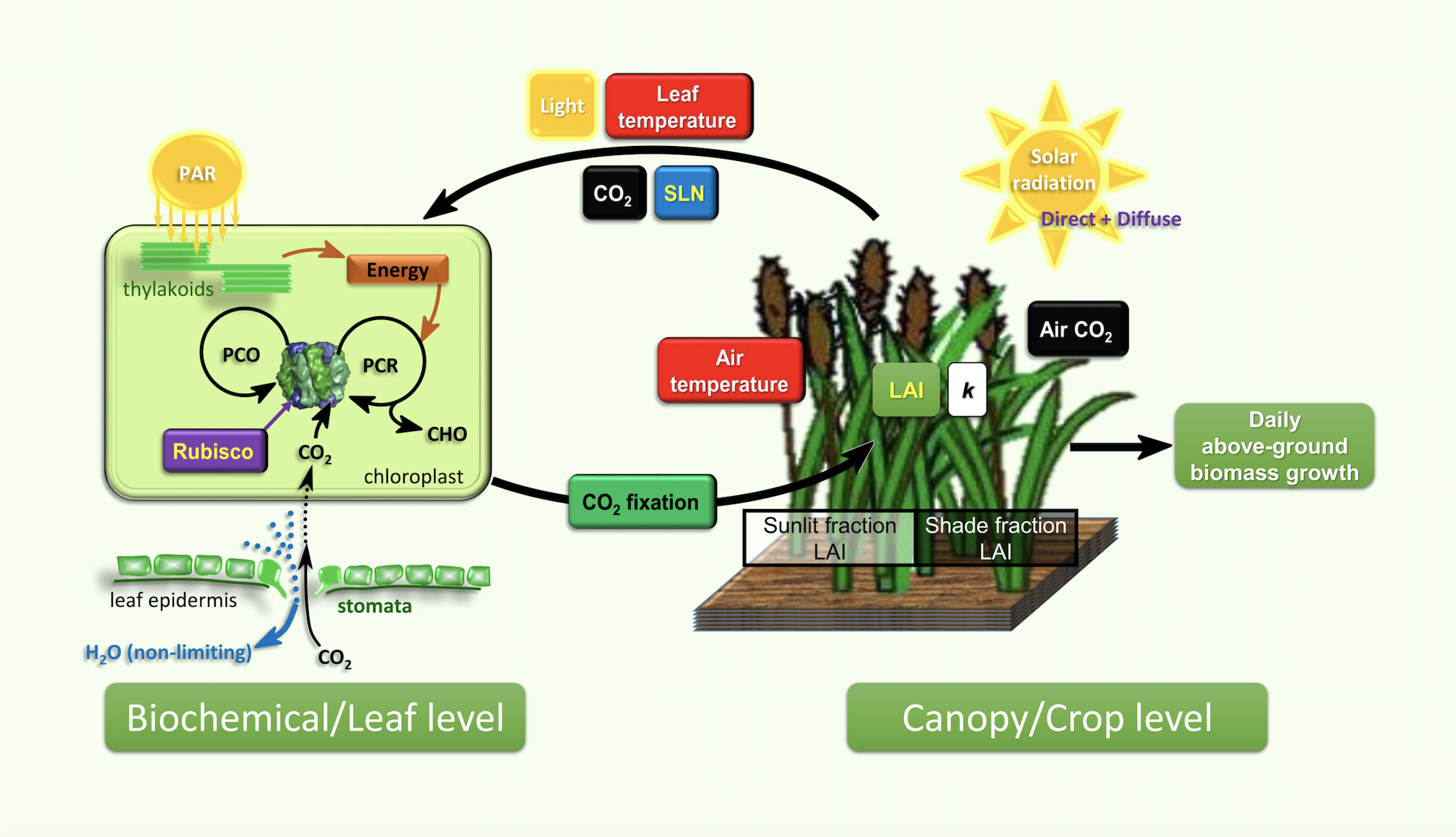
This study was published recently in the journal Functional Plant Biology and was funded by the Australian Research Council (ARC) Centre of Excellence for Translational Photosynthesis and the Queensland Alliance for Agriculture and Food Innovation (QAFFI) at the University of Queensland. Article appeared in “Leaflet” Newsletter of the CoE.
miR156-targeted SPLs as repressors for transfer cell development in Arabidopsis?
29 December 2016
by Suong Nguyen, The University of Newcastle, NSW, Australia
Although it has been two months since ComBio2016, my memory of all the events occurring at the
conference is still fresh as if they happened just yesterday. These were the feelings of admiration, fascination and enjoyment attending plenary lectures, symposia, colloquia and poster teasers, and the pleasurable meetings and conversations I had with colleagues and friends during lunchtime and break-times. Particularly, during the poster sections, I had great opportunities to talk to and discuss my research with many eminent plant biologists, from whom I received constructive comments on the work presented in my poster. One of the most memorable moments at ComBio2016 is when I was awarded the Poster Award on the last day of the conference (which was also my birthday J).
My PhD research at The University of Newcastle has focused on elucidating the genetic controls of the development of transfer cells – a specialised cell type functioning in enhancing nutrient transport in plants. My ComBio2016 poster summarised my recent findings that transfer cell development in Arabidopsis phloem parenchyma is a novel trait specific to vegetative phase change, and that this novel trait is regulated by microRNA miR156 and its SPL target genes. The poster attracted a lot of attention and comments from the conference attendees, which later contributed to improving the manuscript I was drafting to report these findings. A month after the conference I submitted this manuscript to Plant Physiology and then just in the last few days I received notification that the manuscript has been accepted (conditional with minor revisions). A welcome Christmas present!
I would like to take this opportunity to thank ASPS for providing me the Travel Grant to attend ComBio2016 and communicate my research there, and I am very honoured and grateful at receiving the ASPS Poster Award. Besides precious “academic moments” the conference brought me, and as an international student, in exploring the extraordinary beauty of Brisbane. I am very much looking forward to ComBio2017 and a great trip to Adelaide.
2016 Combio poster winner investigates the role of laccases of Botrytis cinerea during grape infection
16 October 2016
by Aruni Buddhika, Charles Sturt University, Wagga Wagga, NSW
I am Aruni Buddhika, 2nd year PhD student from Charles Sturt University, Wagga Wagga, NSW. My PhD research has focused on understanding the role of laccases of Botrytis cinerea during grape infection. I am investigating the differential expression profiles of laccase isoforms during the infection process to elucidate the specific role of each laccase isoform during the infection. I presented some of my research findings at the COMBIO – 2016. I am delighted that I was awarded a student poster prize in the poster competition. This is a really great recognition for my research, and a great encouragement to continue my research carrier. I am really grateful for organizers from ASPS for awarding me the student poster prize. COMBIO-2016 was a great platform for me to learn new things and to share knowledge. The posters were displayed for three days and it was a great opportunity to expose my work for renowned scientist and researchers in the field. I really appreciate the questions, comments and suggestions given since, they will be useful in further development of my research. Plannery lectures were really informative and contained lots of new facts allowing young scientist to learn. Besides meetings, social gatherings were awesome, particularly the conference dinner which made us a great place to meet people and share ideas and knowledge. I am really proud to be a member of ASPS and looking forward to join with the next conference.
ComBio2016 Awards
19 April 2016
- ASPS will make up to 5 awards for research presented as a poster by students at ComBio2016, depending on the number of posters. Each award will consist of recognition at the end of the conference and a prize of $200.
- Student members of ASPS may also apply in advance for a travel award to attend ComBio2016, if presenting their research as either a poster or talk. Applications are due June 10th to the Hon. Treasurer of ASPS: brent.kaiser@sydney.edu.au
- The Peter Goldacre Award is the ASPS award for excellence in early career research. The award ($2000, a medal and invited lecture at ComBio) is sponsored by Functional Plant Biology.
- Award for best paper (2016) by an early career plant scientist published in Functional Plant Biology (certificate, $250 book voucher from CSIRO publishing). Selected from papers published in 2015 in Functional Plant Biology and nominated during the submission process.
- The ASPS Teaching Award may also be presented (certificate and prize) at ComBio2016.
- The R.N. Robertson Lecture will take place at ComBio2016. (The R.N. Robertson Lecture alternates each year with the J.G. Wood Memorial Lecture).
- For more information, http://www.asps.org.au/awards
Science meets Parliament 2016 report
09 March 2016
by ASPS student member Hannah Osborn (@han_osb321)
The sixteenth Science meets Parliament was held in Canberra last week, an event where over 200 scientists descend on Parliament House to learn about politics, policymaking and the media. I was fortunate enough to represent the Australian Society of Plant Scientists alongside Professor Yong-Ling Ruan from the University of Newcastle.
This annual event organised by Science and Technology Australia (STA) is a great opportunity for scientists to inform and excite politicians about science and at the same time learn about politics and the policy, media and parliamentary processes.
The event is held over two days the first day is to prepare us for meeting the politician, the second day is actually meeting them. Professor Brian Schmidt was up first offering many pearls of wisdom from his experiences dealing with politicians. Top tips included “Don’t get defensive”, “Don’t whinge or complain about lack of funding” and remember they’re human! We then heard from journalists Paul Bongiorno and Alison Carabine about the role of media in science. This session covered the importance of being engaging and communicating your science in a simple and direct way. The responsibility of the media to provide alternative views was also discussed with the emphasis on issues like climate change and vaccinations. Both journalists agreed that the alternative view should be proportional to the public interest. I believe the media could have more responsibility here in presenting scientific facts over the “conspiracy theories” but it shows how important it is to clearly and simply communicate your science for the public to make an informed decision.
Following this Catriona Jackson, CEO of STA chaired the session “Getting into policy: how to use science to shape public policy” with Professor Emily Banks, ANU and Dr Subho Banerjee, Department of Education and Training. This was a really interesting session covering the importance of policymakers and how politicians are actually really interested in science, we’re “pushing on an open door” and we need to make the most of this.
The afternoon session was spent working out what to expect from Science meets Parliament by a panel comprising Dr Jeremy Brownlie, STA, Professor Mark Hutchinson, ARC Centre of Excellence for Nanoscale BioPhotonics, Dr Krystal Evans, BioMelbourne Network and Catriona Jackson, STA. The key message here was to make sure you have a key message when speaking with the politician and to know what you want out of the meeting, which could range from informing the politician of your science to inviting them to visit and see firsthand what goes on within your workplace.
Your science in 60 seconds was the interactive final session of the afternoon where Dr Rod Lamberts and Dr Will Grant both from ANU set a strict time limit for us to tell our science story. In a competitive elimination process where only the best moves forward to win a metaphorical bottle of wine all 200 of us got to practice communicating our science succinctly. Actual wine followed at the Gala dinner that night at Parliament House with Minister Christopher Pyne and Opposition Leader Bill Shorten both speaking about the importance of science and innovation.
The second day of Science meets Parliament involved actually meeting a politician. Personally, my experience was fantastic if not all too brief as the realities of life as a politician became clear. Throughout the rest of the day we were entertained by Q & A sessions with Professor Ian Chubb, former Chief Scientist as he reflected on his experiences in this position and then Senator Kim Carr, Shadow Minister for Higher Education, Research, Innovation and Industry. Senator Carr put into words how I believe a lot of people were feeling that CSIRO is not a glorified consultancy and if we keep going that direction we will undermine its status as our nations research centre completely.
The new Chief Scientist Dr Alan Finkel gave his first address at the National Press Club which I unfortunately missed as my meeting clashed with this event but I did get to attend the reality show also known as Question Time for the House of Representatives.
The day ended with a panel of politicians all passionate about science chaired by Genevieve Jacobs from ABC Canberra with Professor Aidan Byrne, ARC, the Hon Karen Andrews, Assistant Minister for Science, the Hon Richard Marles, Shadow Minister for Immigration and Border Protection and Dr Adam Bandt, Industry, Energy, Science and Research spokesman.
Overall, the take home message from Science meets Parliament 2016 was Professor Graham Durant’s comment “science isn’t finished until it’s communicated” which is something we should all remember and include as an important part of our research.
Report of Education Sessions at ComBio 2015
10 January 2016
Adapted from an article published in the December 2015 issue of the ASBMB magazine, the “Australian Biochemist”, by Gonzalo Estavillo and Janet Macaulay.
High profile educators, science communicators and academics passionate about teaching participated in the two education focused sessions held at ComBio2015, organized by ASPS and ASBMB. The main themes were ‘Challenges in Research Training’ for the lunch workshop and ‘Innovations in Undergraduate Education’ for the concurrent symposia, both on Tuesday 29 September.
Both sessions were well attended by more than 50 people in each providing a good opportunity for both audience and speakers to exchange their thoughts and practices about university science education. The sessions were coordinated by the Education Representatives from the ASBMB and ASPS, Associate Professor Janet Macaulay (Monash University) and Dr Gonzalo Estavillo (CSIRO Agriculture), respectively.
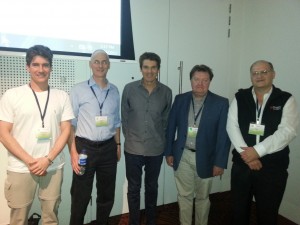
Education Session I, from left: Gonzalo M Estavillo (co-Chair), Martin Stone, Graham Phillips, Alastair McEwan and Terrence Piva (co-Chair).
Associate Professor Martin Stone (Director of the MBio Graduate School, Monash University) kick-started Education I: ‘Challenges in Research Training’ session discussing efforts on how to map skills training onto target competencies for graduate students. Five main core competencies for PhD students were identified, including subject area knowledge, technical expertise, critical thinking, communication skills and professionalism. This program has implemented a ‘competencies assessment rubric’ to help students and supervisors assess their progress. Martin highlighted the need for developing a sense of professionalism, defined as self-respect, organisation skills, and ability to prioritise work, as well as being a team player. Finally, Martin identified time, resources and reaching a consensus on what and how to teach as still being the main challenges in graduate education.
The second talk of the session was presented by the Dean of the UQ Graduate School, Professor Alastair McEwan. Alastair described a framework identifying transferable skills for employability of PhD graduates. Alastair highlighted that undertaking a PhD “is not a waste of time and that the skills that can be gained” can be used in other profession employment positions. Interestingly, Alastair discussed that the most successful economies of Scandinavia have three to five times more researchers in business enterprise compared to Australia, which is remarkable given that both countries have about the same number of researchers. The challenge learnt is to insure that the skills learnt can be transferred during the PhD directly into the job market. Although the professional skills are relatively easy to acquire and measure during the PhD, transferable skills, that is, skills applicable to other jobs, are not so easy to track. Although transferable skills could be taught during boutique workshops and professional development courses (such as VITAE) and industry placements, they are much harder to assess. Placement or short stays in other organisations could be a good way to assess transferable skills.
Finally, Dr Graham Phillips gave an informative talk about his experiences as a science communicator and why he chose science communication as a career path. Graham is a well-known science communicator from the ABC’s Catalyst with a PhD in astrophysics. He also teaches an introductory science communication course co-convened with Associate Professor Ros Gleadow at Monash University. Graham argued that people in most jobs, including scientists, “need good communication skills… and need to have proof of it”. Moreover, he pointed out that “we want to hear more scientific points of view in the media”, highlighting climate change as an example where the participation of more scientists would greatly benefit the debate. “Know your audience and present the big picture story” was his advice to people keen on science communication to a non-specialised audience. Extra time in the Education I session allowed for a very interesting Q&A session between panellists and the audience, which completed this highly educational symposium.
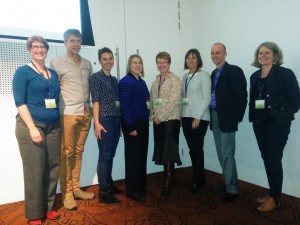
Education Session II, from left: Heather Verkade (co-Chair), Peter Arthur, Beth Loveys, Karina Riggs, Susan Rowland, Ros Gleadow, Patrick Schaeffer and Janet Macaulay (co-Chair)
Education II: ‘Innovations in Undergraduate Education’ started with a presentation by Dr Peter Arthur, winner of the 2015 ASBMB Beckman Coulter Education Award. Peter discussed a process which had been introduced at UWA to measure the effectiveness of achievement of teaching goals within lab classes. This system allows review of assessments to ensure alignment of assessment and instruction. Peter was followed by Associate Professor Ros Gleadow who spoke about harnessing digital tools to improve undergraduate teaching. Ros has redesigned the landing screen and general format of the Moodle site to a more student friendly and engaging format which is more interactive, enabling greater student collaboration. She uses social media tools such as Twitter and Facebook to closely engage with the students.
The next presentation was a team presentation by Dr Beth Loveys and Dr Karina Riggs who discussed flipping laboratory classes. Their model of a flipped class enables the incorporation of learning activities covering the range of Blooms taxonomy – pre-class: remember and understand; during class: apply and analyse; and post-class: evaluate and create. They use online pre-practical activities to ‘flip the laboratory’ with agriculture and viticulture science students. They also argued that students gained broader knowledge, better understanding and gained greater confidence after those pre-practical activities. Importantly, students’ marks significantly increased after their new approach. Dr Patrick Schaeffer then discussed a successful approach taken in a biotechnology course to prepare students for real world challenges. The molecular biology course integrates experimental design, critical and analytical thinking and laboratory work in real-world situations. Associate Professor Susan Rowland discussed the struggles and issues associated with undergraduate research. This presentation discussed the scale of student experiences from standard practical classes to ALURE (Authentic Large-scale Undergraduate Research Experience) to URE (Undergraduate research experience). Susan talked about the ALURE project and the issue of what is authentic research. Collectively all these speakers delivered highly insightful presentations which opened up deeper thought on how we can all be more effective in our communication delivery and better approach the road to educational discovery.
Great outreach opportunities for the ASPS Plant Science Education Rep
15 November 2015
By Gonzalo M. Estavillo – Plant Science Education Representative (2013-2015)
The Australian Society of Plant Scientists (ASPS ) is a scientific society promoting all areas of plant related research. ASPS nurtures the next generation of plant scientists and has the potential to educate the non-specialized audience about the importance of plants and plant research. Our society offers a unifying representation of plant scientists across Australia that collaborate with international plant science organizations linked through the Global Plant Council.
It has been highlighted that “the planet needs more plant scientists” to meet future demands for food and fibre, an issue that appears further compounded by an increase in the average age of plant scientists in some parts of the world. Future plant scientists will need to be equipped with a deep knowledge of the plant sciences and armed with cutting edge technologies to address future climate change issues that challenge food security and plant biodiversity. As importantly, sustainable agricultural systems will need to operate with less arable land and water resources. Scientific societies such as ASPS have the potential to ignite new interest in plant science and help attract younger minds to identify new solutions to current and emerging problems.
The “Plant Science Education Representative” coordinates and promotes the education and outreach efforts for ASPS. In addition to the “Education Rep”, six “Discipline Representatives” are responsible to drive agendas in specific research areas in close coordination with the Executive Committee.
The Education Rep is commissioned important tasks for science outreach, recognition and communication, in addition to the general Discipline Representative duties. For example, the Education Rep organizes two Education sessions at the annual biology conference ComBio along with the corresponding Representative for the Australian Society for Biochemistry and Molecular Biology. These sessions include a lunch workshops featuring high profile speakers, such as the Chief Scientist or professional science communicators, as well as symposia concurrent with scientific sessions, where the keynote speakers are teaching prize awardees.
The ASPS Teaching Award recognises innovative contributions to undergraduate teaching. The Education Rep chairs an ad hoc committee composed by an external teaching academic and a student to rank the applications and recommend the most outstanding one as the award recipient. The Education Representative is also responsible for continuous development and maintenance of the Teaching section of the ASPS website.
Different Social media platforms allows ASPS to interact with its members and communicate plant sciences to non-specialized audiences. These tools, and current initiatives such as FoPD and National Science Week provide excellent outreach opportunities to effectively communicate the importance of plant research to our society while enhancing the profile of the ASPS and its members. Education and effective communication of our science are the means to inspire the new generation of plant biologists.
About The Australian Society of Plant Scientists
09 September 2015
This article was written for the Global Plant Council (GPC) and originally entitled “A Postcard From… The Australian Society of Plant Scientists”. It first appeared on the GPC blog. You can follow GPC activities on twitter @GlobalPlantGPC”.
The Australian Society of Plant Scientists (ASPS) promotes plant science in Australia, and provides professional contact within our community of teachers and researchers in plant biology. Originally founded in 1958, the ASPS currently has approximately 400 members from Australia and also overseas. It provides a forum for knowledge exchange so that the membership can build on both the depth and breadth of knowledge of plant functions. ASPS offers a unifying representation of plant scientists in Australia, and is linked with the Global Plant Council and many other important international plant science organizations.
One of the main activities of the ASPS is to provide mutual support and collective mentorship to facilitate the dissemination of new research. For example, there has been a long and mutually supportive interaction between ASPS and Functional Plant Biology, which is perhaps the most prestigious journal of the Commonwealth Scientific and Industrial Research Organisation (CSIRO). ASPS is one of the foundation partner societies of ComBio, the annual international biology conference held in Australia. ASPS also sponsors other specialist workshops upon request.

ComBio meeting 2014. ComBio is the combined annual meeting of ASPS, the Australian Society for Biochemistry and Molecular Biology (ASBMB), the Australia and New Zealand Society for Cell and Developmental Biology (ANZSCDB), the New Zealand Society for Biochemistry and Molecular Biology (NZSBMB) and the New Zealand Society of Plant Biologists (NZSPB). This year it takes place in Melbourne, 27th September – 1st October: http://www.asbmb.org.au/combio2015/
The Society aims to nurture a new generation of plant scientists in many ways. It sponsors student attendance to ComBio through travel awards, and encourages active student participation by awarding poster prizes. Additionally, the RN Robertson Travelling Fellowship is available to students and early career researchers to support their research in another laboratory so as to widen their experience and raise their profile.
ASPS rewards excellence at all levels of scientific career development. Eminent plant scientists are invited to give the JG Wood or RN Robertson lectures at ComBio, in honour of the first two Presidents of the Society. Outstanding young plant scientists are recognized every year by the Peter Goldacre Award and the ASPS–FPB Best Paper Award. The commitment of ASPS to plant science education is reflected by both the ASPS Teaching Award, which recognizes innovative contributions to undergraduate teaching, and the development of online resources for plant biology teaching such as Plants in Action.
The Society’s social media platforms work with members to enhance their ability to do research and to educate others in plant sciences. The ASPS website offers the opportunity to connect with other members, get updates on the latest plant science research around the world, post jobs, student scholarship opportunities and conference announcements, and provides a growing collection of teaching resources for plants sciences. Phytogen is the Society’s newsletter blog to inform our own members and general readers with an interest in developments in Australian plant science, provide a vehicle for communicating new ideas, recent professional experiences, and forthcoming events. Finally, we use our Facebook and Twitter (@asps_ozplants) accounts to interact and engage with both scientific and general audiences. Meet us and view our photos in our ASPS Facebook page!
This pioneering ‘Postcard From’ was prepared by Gonzalo Estavillo and John Evans.
Global Plant Council
29 August 2015
By Lisa Martin, GPC.
Did you know that as a member of the Australian Society of Plant Scientists, you’re also a member of the Global Plant Council?
What is the Global Plant Council?
The Global Plant Council (GPC) is a non-profit coalition of plant, crop, agricultural and environmental science societies from across the globe. It was founded in 2009 to provide a body that can speak with a single, strong voice in the policy and decision-making arena, at the global level. By connecting plant science organizations, we are bringing together all those involved in plant and crop research, education and training, to harness the wealth of knowledge and expertise found within our membership base to strengthen and facilitate the development of plant science for global challenges.
What does the GPC do?
The GPC currently has 29 Member Organizations – of which the Australian Society of Plant Scientists is one – representing over 55,000 plant and crop scientists across Europe, North and South America, Africa, Asia and Australasia. By bringing these groups together, we promote collaboration and cross-communication between scientists and societies, with a focus on key projects in priority areas. Some examples include:
- Diversity Seek (DivSeek): The GPC is working with partner organizations to bring together germplasm curators, plant and crop researchers, breeders and computational experts to unlock the potential of crop diversity stored in genebanks around the world. For more information, see divseek.org.
- Plantae.org: Together with the American Society for Plant Biologists, the GPC is helping to develop Plantae.org, a forthcoming digital networking platform that will provide researchers, students, industry professionals and educators with access to plant science news, research, methods, teaching resources, funding opportunities and more from across the globe.
- Stress Resilience: Together with the Society for Experimental Biology, the GPC is hosting a Symposium on Plant Stress Resilience in Brazil in October 2015. This meeting will bring together experts in this field to showcase new approaches and technologies, share research knowledge and expertise, and facilitate cross-cultural networking and collaborations. Registration and abstract submission are open, so please consider joining us!
- Education and training: The GPC is working with volunteers and organizations to identify and share tools and resources to train and inspire the next generation of plant scientists, as well as translate these materials into many languages to expand their global reach.
As well as these activities, the GPC coordinates and manages a website, blog, and a monthly e-newsletter to help its members stay connected and up to date with global plant science research. You can also follow us on Twitter at @GlobalPlantGPC (or in Spanish at @GPC_EnEspanol), or on Facebook.
How can the GPC help me?
The GPC is directed by an Executive Board of leading figures from the world of plant and crop science research, and we also have a panel of elected representatives from each of our Member Organizations. We encourage you to communicate with the leaders of your local plant science organizations so that they can feed back to us the issues, needs and opportunities faced by plant scientists in your region.
As well as our Executive Board, which meets on a quarterly basis, the GPC has a small staff that manages the day-to-day running of the Council. Ruth Bastow is our Executive Director, and Lisa Martin is the Outreach & Communications Manager – if you have any upcoming events, funding opportunities, or exciting news to share we will be pleased to help promote these via our website, newsletter and other outreach channels. In addition, you might like to contribute an article to our blog to raise awareness of an issue, important research, an event or project in your area.
The new online plant science community platform mentioned above is still in development and will be a fantastic resource when it is finished – stay tuned! The GPC website is also a useful source of information – we have a comprehensive Events calendar to help you find meetings, conferences, workshops and symposia to attend, and our Resources area provides a range of useful documents, reports, awards, funding opportunities and other information for plant scientists. You could also sign up for our monthly e-Bulletin newsletter.
How can I help the GPC?
There are many ways you can help! Firstly, why not consider making a donation to the GPC? The GPC is not-for-profit and although our Member Organizations pay an annual membership fee, our costs are not entirely covered by this income. We therefore seek donations – however big or small – from individuals, philanthropists, funding bodies or other organizations to help us continue the important work we do.
As a global organization we know that not everyone around the world speaks or understands English, yet the majority of resources for the plant sciences are written in English. If you speak another language and would be willing to help us translate resources such as teaching tools, videos, protocols and other documents into your mother tongue, we would love to hear from you!
Another way you might like to get involved with the GPC is to help raise awareness of the work we do. If you have been invited to speak at a local, national or regional plant science event in the coming months, and would like to say a few words about the GPC, we have some PowerPoint slides and resources to help you spread the word.
We are also conducting a survey of research projects around the world that are associated with stress resilience in plants, and separately, we are also collecting information about maize research around the world. If you work in either of these areas, please tell us about your work!
For more information please contact Lisa Martin
Outreach & Communications Manager , Global Plant Council
Bow House, 1a Bow Lane, London, EC4M 9EE, UK
lisa@globalplantcouncil.org
www.globalplantcouncil.org
@GlobalPlantGPC
+44 (0) 7716 164682
About the newly created ASPS “Website & Communications Sub-Committee (WCSC)”
21 November 2014
The “Website & Communications Sub-Committee (WCSC)” has been established at our last 2014 AGM. The main goal of the WCSC is to disseminate information related to ASPS and plant biology among the Society members and the general public.
The WCSC is in charge of updating the content in the social media platforms representing ASPS and formatting the website. In addition to our www.asps.org.au website, ASPS manages a Facebook page (www.facebook.com/ASPSozplants) and a Twitter account (@asps_ozplants). WCSC will also liaise with ASPS members seeking suggestions about the website functionality and content in an attempt to improve exposure, interest and visibility.
The WSCS consists of four ASPS members and one ASPS student representative. The WSCS is chaired by Dr Gonzalo Estavillo. Dr Janet Wheeler provides technical support and coordinates the website maintenance with the developer (Michael Major Media); Conjoint Professor Tina Offler and Dr Chris Cazzonelli help with content design and the editing of “Phytogen”. Christina Delay is the student representative that helps to coordinate and manage social media, interact with other student members, and provide feedback to the other members of the WSCS.
We would like to encourage all members to send their suggestions and ideas about how to improve our ASPS website and help disseminate our activities to
- WSCS chair (gonzalo.estavillo@csiro.au) or
- student representative (christina.delay@anu.edu.au).
Recent Posts
Tags
Archives
- June 2025
- May 2025
- April 2025
- March 2025
- February 2025
- January 2025
- December 2024
- November 2024
- October 2024
- September 2024
- August 2024
- July 2024
- June 2024
- May 2024
- April 2024
- February 2024
- January 2024
- November 2023
- October 2023
- September 2023
- August 2023
- July 2023
- June 2023
- May 2023
- April 2023
- March 2023
- February 2023
- December 2022
- November 2022
- October 2022
- September 2022
- August 2022
- July 2022
- June 2022
- May 2022
- April 2022
- March 2022
- February 2022
- January 2022
- December 2021
- November 2021
- October 2021
- September 2021
- August 2021
- July 2021
- June 2021
- April 2021
- March 2021
- February 2021
- January 2021
- December 2020
- November 2020
- October 2020
- September 2020
- August 2020
- July 2020
- June 2020
- May 2020
- April 2020
- March 2020
- February 2020
- January 2020
- December 2019
- November 2019
- October 2019
- September 2019
- August 2019
- July 2019
- June 2019
- May 2019
- April 2019
- March 2019
- February 2019
- January 2019
- December 2018
- November 2018
- October 2018
- September 2018
- August 2018
- July 2018
- June 2018
- May 2018
- April 2018
- March 2018
- February 2018
- January 2018
- December 2017
- November 2017
- October 2017
- September 2017
- August 2017
- July 2017
- June 2017
- May 2017
- April 2017
- March 2017
- February 2017
- January 2017
- December 2016
- November 2016
- October 2016
- September 2016
- August 2016
- July 2016
- June 2016
- May 2016
- April 2016
- March 2016
- February 2016
- January 2016
- December 2015
- November 2015
- October 2015
- September 2015
- August 2015
- July 2015
- June 2015
- May 2015
- April 2015
- March 2015
- February 2015
- January 2015
- December 2014
- November 2014
- October 2014
- September 2014
- August 2014
- July 2014
- June 2014
Copyright 2017 Australian Society of Plant Scientists Disclaimer & Privacy
Website by Michael Major Media

